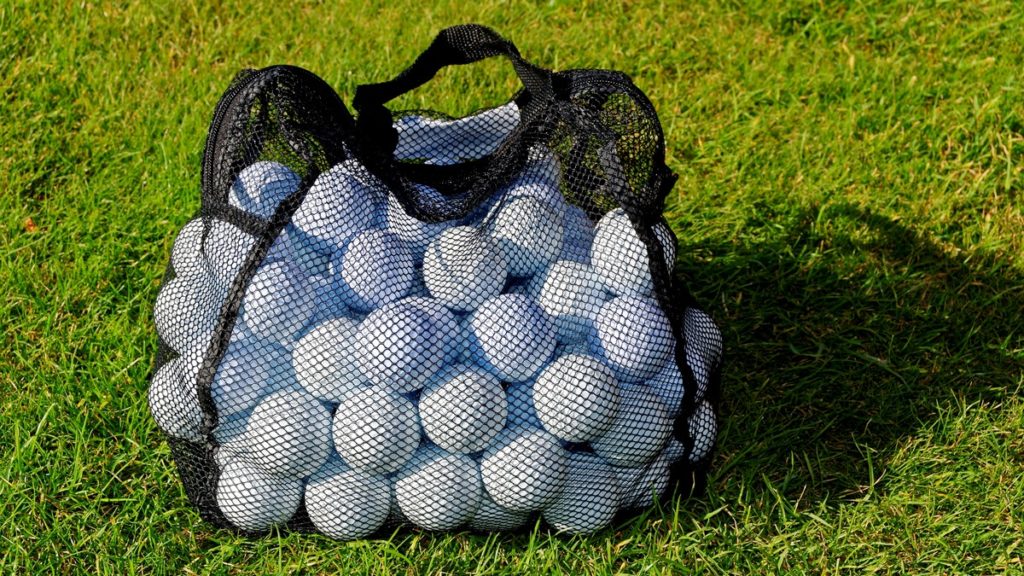Do you struggle to take your ‘range game’ onto the golf course? The problem is one of not practising the skills you need to play golf – and also failing to appreciate the value of some basic stretches and warm-up drills. So let me share with you some thoughts on structuring a better practice session – ideas that can prove beneficial whether you have just an hour or several hours each week to work on your game.
By Dan Frost
The Warm-Up
A good golf swing involves all the related muscle groups in the body, and so before you actually hit balls give a little thought to some basic warm-up exercises. All you need is 5-10 minutes to prepare your body to swing the club with flow and a few simple stretches will do that. Added flexibility not only helps prevent injury but encourages the turning of the torso in the backswing. This is the key element of the swing that produces power: a full balanced turn of the upper body, coupled with a lower body that supports and stabilises this turn. Young or old, beginner or expert, stretching will help you keep your athletic edge and give you the greatest chance of shooting low golf scores. Remember to perform each of the stretches slowly and to your own level, making sure that you never hold your breath.
Hamstring stretch
This is one of the most common stretching exercises there is, and yet it is often neglected when it comes to golf. Tight hamstrings have a negative effect on our ability to maintain good body angles when we swing the club. Without that strength in the thighs it is also very difficult to stay ‘grounded’ and balanced, which can lead to further inconsistency. To rehearse the hamstring stretch, stand with your feet at shoulder- width, arms hanging in front of your body, a club in your fingertips. Then, from an upright position, tilt slowly forward towards the ground, ensuring that you inhale and exhale. Bend only as far as you can comfortably go – and hold that position for a 15 seconds. You don’t have to keep your legs completely straight; flex the knees lightly. Holding the position, you will feel the hamstrings being stretched. Return to a standing position and repeat several times.
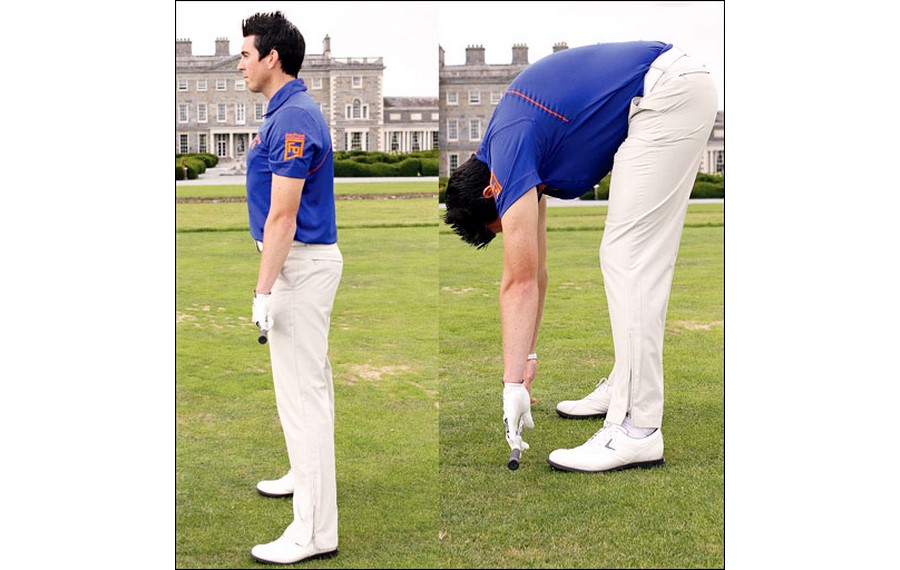
Wrist/forearm stretch
Warming up the hands, wrists and forearms is key to creating control in rotation and hinge. It also encourages better feel and makes it easier to blend your swing with the turn of the big muscles. Hold two golf clubs together out in front of you, gripping the shaft six inches from the hosel. Now simply make clockwise and anti-clockwise rotations, keeping flow. Do this with the right and left arms. You will probably find one arm less well-coordinated than the other – perhaps something to work on?

Side stretch
In an effective swing the body will create side bend through the torso and hips. And so these all-important muscles need to be stretched. To do so, hold a club down your back, positioning it along your spine, and securing it at both ends. From a regular standing position, tilt gently to either side with minimal hip movement. When you tilt to the left you should feel the stretch down the right side of the body, and vice versa. Hold for 15 seconds on each side.

Backswing stretch
Here’s a really good golf-specific exercise that will do wonders for your torso mobility, improving your backswing turn and allowing the arms to more easily support the club. Place a rolled up towel across the top of your shoulders as you settle into a good posture, and focus on the motion you need for a good backswing – ‘loading’ your weight onto the right side as you turn against the flex in the right knee. Hold for 15 seconds. As your right hip rotates to clear the way for the turning of the chest you should feel a resistance running down the inside of your right thigh. Moving into the through-swing, try to keep your head steady as you unwind to point your right shoulder down, the resistance this time felt on the inside of the left leg. Once you have done this a few times you’ll notice the flow.
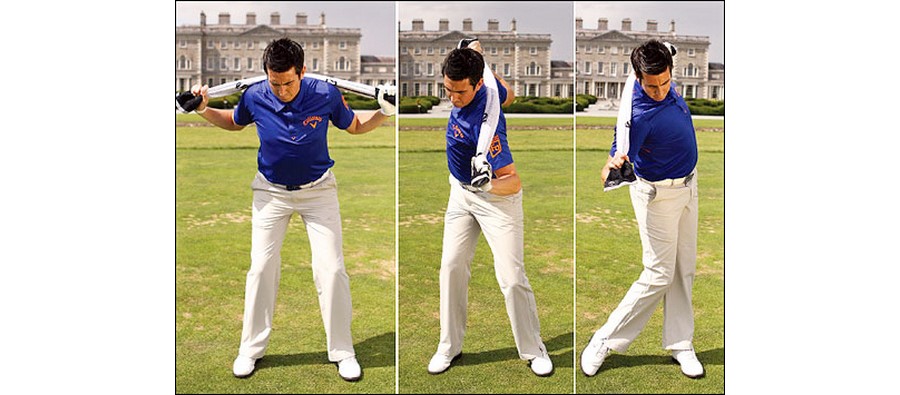
Step into your natural rhythm…
Once you have stretched out your golfing muscles, take a couple of minutes to get your swing flowing with this simple step drill. It will wake up your natural athletic instincts, ready to get down to the business of hitting balls. What this does so well is improve the ‘sequencing’ of your swing and the overall dynamic balance of your motion. All you have to do to enjoy this is start with your feet together, and then make a smooth and compact backswing before literally taking a step forwards with your left foot. Use that step to reverse your momentum and free-flow all the way to a good finish. Remember: narrow, load, step and flow.

ADVANCED: Shoulder stretch
This is a more advanced stretch – one for all the young and flexible golfers out there. A lot of pros on tour use this in their stretching routine as it really does improve shoulder flexibility. With the feet at shoulder-width, grip a club behind you and get into a good posture. Then bend forwards as though you were trying to touch your toes, simultaneously raising your arms as far as you can up over your head. Many of the best players in the world are able to raise their arms all the way over their head, demonstrating exceptional flexibility. Do this stretch slowly, as it will feel unfamiliar and will take some getting used to.
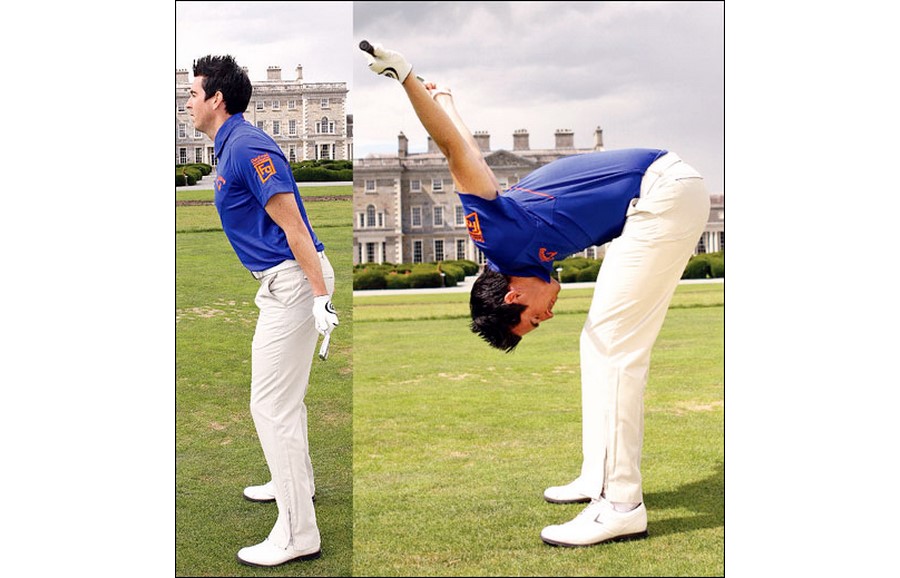
Technical Work
There are certain aspects of what you might call ‘technical work’ that are helpful to the majority of golfers – working on body turn and ‘coil’ being one of them. I’m a big advocate of drills that have a lasting effect, so that when you come away from the exercise you automatically follow the same patterns of movement. You need to talk to your golf coach to identify the key areas of technical work that you should focus on, but to get the ball rolling here are a few simple drills that I use regularly with my pupils.
Build a strong foundation
A strong lower half is key to creating coil, sequence and balance in the golf swing. So at the start of a ‘technical session’, I advise my pupils to increase their awareness of body rotation without holding a club in their hands. Wrapping a resistance band just above the knees in the address position serves to heighten the awareness of the lower body as you rehearse your body motion – it will feel grounded and strong. Place your arms across your chest and then make your backswing turn, your focus on working the left shoulder slightly down as you turn to the right and vice versa. As you do so, keep the width between the knees constant so that the band is stretched. You can pick up these resistance bands in most sports shops – and they really are useful in these warm-ups and work-outs.
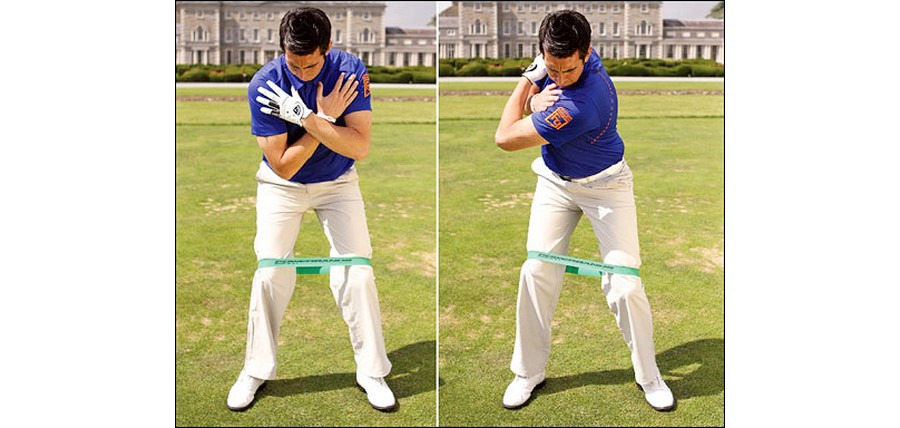
Practice a compact move
The most effective practice drills have sequence and flow about them, and if we add a second resistance band around the arms, the exercise that you see me rehearsing above is taken a stage further as you blend arm-swing to good body rotation (below). Having shorted the band to the desired length, slip it up your arms, just above your elbows, and then go ahead and make a series of slow and controlled swings, your focus on keeping your knees ‘solid’ as you load into the backswing and then ‘soft’ as you flow into a finish. That band around the arms will encourage an effective symmetry between your torso, arms and the club, the elbows working nicely together throughout the entire motion. You can hit shots doing this.

Improve your swing synchronicity

Balance and sequence are two of the most important keys to repeating a powerful golf swing. This hoop drill allows you to synchronise the movement of your arms with the turn of the torso. Rather than having a resistance band to hold me in place (as per the previous drill), I work with my arms positioned inside the hoop to create a great working relationship between my arms, torso and club, which helps to keep the club on plane. I really love the idea of a circle working in a circular shape around my body. This is a great image for you to have when you think of the golf swing.
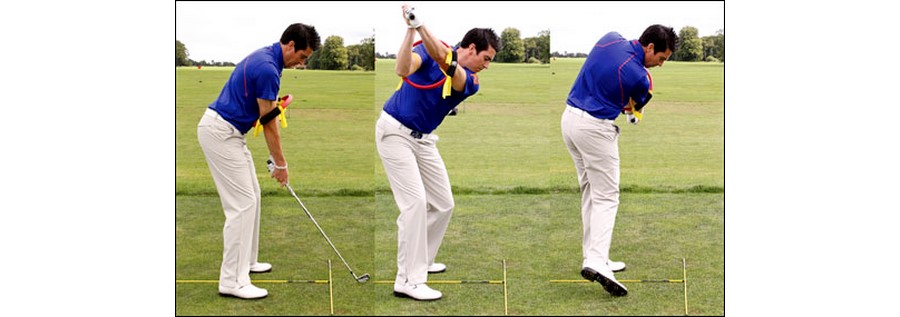
VIDEO FEEDBACK: Feel & Real?

Thanks to the wonders of technology we can now very easily refer to instant playback of our swing. And while this can be a powerful practice companion, you do have to be careful when it comes to studying video – and the key is to use it to confirm positives rather than look at the negatives. By that, I mean don’t be too analytical but look for things like flow and balance and really try to get a sense for whether what you are feeling matches up with the reality. Bear in mind also that the way the camera is positioned can have a big effect on your view of the swing. If you are going to use video, try to position the camera at waist high and directly in line with the ball-to-target line (as you are looking ‘down the line). For comparison, make sure the camera is at the same height when filming from face-on. Elite level players may also find it interesting to see their swing from the target – i.e. hitting straight over the camera. Of course there is an inherant risk here, but if you are bold enough you quickly see where the energy in your swing lies.
Challenge
The final component of a good practice session is the aspect most often overlooked – the ‘challenge’ of engaging with a target. This gets you ‘course ready’. It is the most realistic part of a practice routine in terms of replicating the skills you actually need to play golf – i.e. to focus on specific targets, to think about precise yardages and to experience a full array of different shots.
Accuracy drill
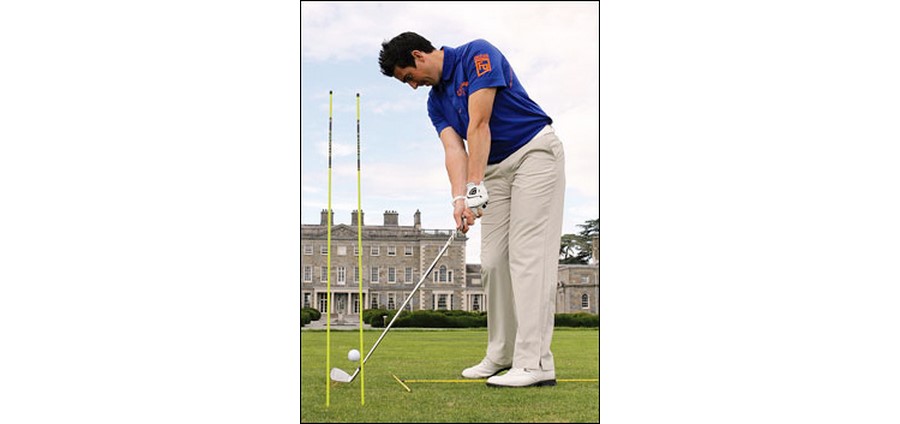
Those brightly coloured alignment poles you see all the juniors at the club carrying are not just for show. I first saw Columbian tour professional Camillo Villegas using this drill on the driving range and have since used it to inspire many of my students to appreciate the real meaning of focus as it relates to shot-making accuracy. All you have to do is create a ‘gate’ on the line of the shot a yard or so ahead of the ball you are playing. The challenge is then to fly the ball straight through the gate en route to your target. Villegas had the poles set to about a clubhead’s width – the question is, how accurate are you?
Recreate a hole
Picturing a hole in your mind is a great way to transfer skills from the range out onto the course. It’s also a great way of engendering a positive emotion for a hole you may have previously played poorly (in other words, if there’s a ‘bogey’ hole that you always fear, you can learn to deal with it here on the range). Take a few moments to close your eyes and picture a certain hole in detail, making it as vivid as possible. Better still, draw a sketch of the hole in a notebook. The key then is to go deliberately through a pre-shot routine, and play the hole with consequence – i.e. you only have one chance to score well. Make practice a reality.
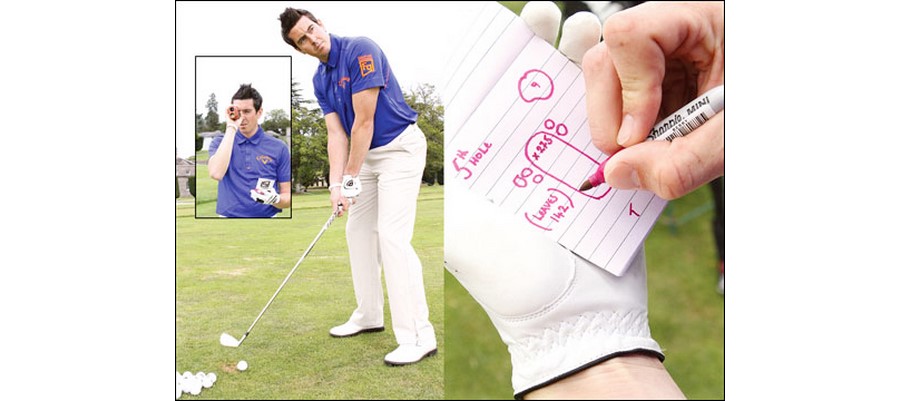
Practice tough shots
We are all guilty of practising the shots we are good at, the ones we find most enjoyable. John Jacobs, one of the finest golf coaches of all time, once described these types of practisers as ‘pickers’, as they only ever practised from a lie they picked. Given just how unpredictable the game can be, it is vital that you practice every scenario that you may encounter on the course, so try mixing things up. How does the ball react from a sandy divot? What sort of yardage do you get from the rough? Can you land a ball softly hitting a high lob shot over a bunker? Thinking about what might happen will put you into the frame of mind of real life on-course performance.

